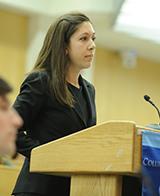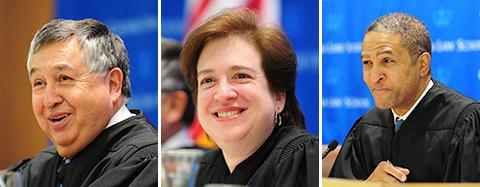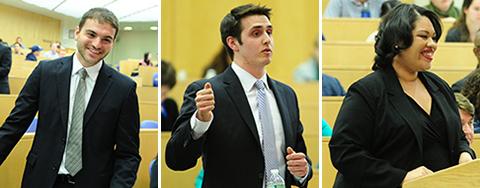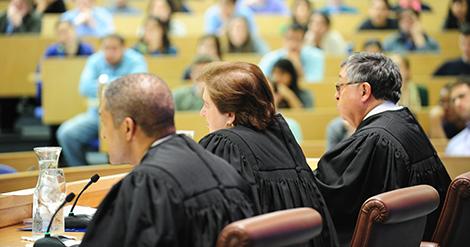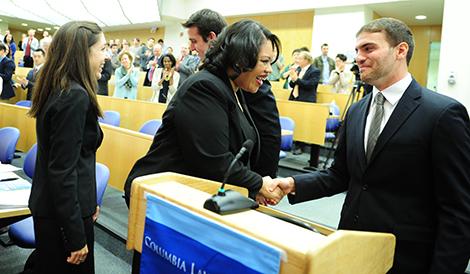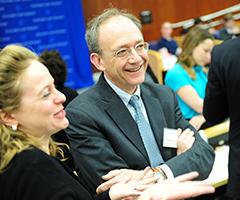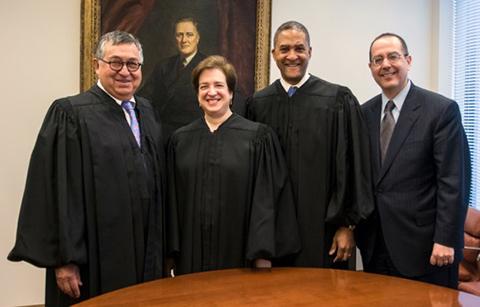Beatrice C. Franklin '14 Awarded Best Oralist at Paul, Weiss Harlan Fiske Stone Moot Court Finals
Four Students Present Arguments Before U.S. Supreme Court Justice Elena Kagan and U.S. Court of Appeals Judges Raymond J. Lohier Jr. and Carlos F. Lucero
New York, April 16, 2014— Four Columbia Law School students faced spirited questioning from a sitting U.S. Supreme Court justice and two judges from the U.S. Courts of Appeal as they addressed a complex web of constitutional claims at the Paul, Weiss Harlan Fiske Stone Moot Court Competition finals on April 7.
| Beatrice C. Franklin '14 won the Lawrence S. Greenbaum Prize for best oralist and the award for best brief at the end of the competition. |
But in the end, the judges awarded Beatrice C. Franklin ’14 the Lawrence S. Greenbaum Prize for best oralist. Franklin also won the award for writing the best brief in the final round of competition. The other finalists were: Franklin’s co-counsel Benjamin A. Cornfeld ’14, and their opposing counsel Phillip Cushing ’15 and Dinah M. Manning ’14.
The competitors had plenty of support from classmates, faculty members, and the finalists’ friends and family, who packed into Jerome Greene Hall to watch the prestigious appellate advocacy competition before U.S. Supreme Court Associate Justice Elena Kagan, Judge Raymond J. Lohier Jr. of the U.S. Court of Appeals for the Second Circuit, and Judge Carlos F. Lucero of the U.S. Court of Appeals for the Tenth Circuit.
Franklin said after the competition that it was an honor to appear before the judges.
“It was particularly interesting to see how they approached the case, connecting it to other areas of the law and thinking about how it would look in the real world,” she said.
The judges, who later described themselves as a “hot bench,” riddled the students’ arguments with rapid-fire queries but also kept the finalists—and audience—in good spirits with their sense of humor. At one point, Lohier paused to wonder aloud whether he should call Kagan “Justice,” as her real-life position requires, or “Judge,” in keeping with her role on the moot court’s fictional panel of the U.S. Circuit Court of Appeals for the First Circuit.
Kagan looked down at the nametag in front of her seat and tapped it.
“It says ‘Justice’ here,” she deadpanned. “Or it’s ‘Chief Judge’ to you.”
| (from left to right) 10th Circuit Judge Carlos F. Lucero, U.S. Supreme Court Associate Justice Elena Kagan, and 2nd Circuit Judge Raymond J. Lohier Jr. kept the finalists on their toes during the formal proceedings, and were engaging and insightful when they offered students feedback and compliments. |
Difficult Case
After the argument, the judges praised all four competitors but acknowledged the uphill battle faced by Cushing and Manning. The pair was tasked with defending a city “holiday display” ordinance that, among other provisions, limited where religious and non-religious displays could be posted, allowed displays to be larger depending on the size of the group responsible for the display, and provided matching funds for lower-budget displays as a penalty against higher-budget displays.
“You should all be incredibly proud of yourselves, but one side had an easier time than the other because—come on, how many ways was this statute unconstitutional?” Kagan joked, prompting laughter throughout the lecture hall.
Looking toward Franklin and Cornfeld, who represented a fictional church that claimed the ordinance violated the Constitution’s establishment and freedom of speech clauses, she added, “We tried to give you hard questions too, but at least you had answers I could imagine.”
Mastering the Art of Oral Argument
Fifty-four students vied throughout the year for the chance to appear before their peers and professors as well as the formidable bench. The judges said the four finalists each excelled at one of the most important features of appellate practice: engaging in a conversation with the bench—even when that means conceding a point or two—rather than robotically stating an argument.
“You answered our hypotheticals and questions with poise—and you listened,” Lohier said. “In oral argument, people listen to each other.”
| Along with Franklin, (from left to right) Benjamin A. Cornfeld '14 argued for plaintiffs challenging a holiday display ordinance while Phillip Cushing '15 and Dinah M. Manning '14 argued in defense of the city that passed the law. |
Franklin took charge of her establishment clause claims from the moment she stepped up to the podium. When Kagan asked if the judges should credit the city for providing matching funds to religious and non-religious displays alike, Franklin said such neutrality didn’t matter.
“What matters is that the government is endorsing any religious groups at all,” she said.
Arguing for the city, Franklin’s opposing counsel Cushing said the ordinance avoided entanglement with religion because it distributed funds regardless of a group’s message. But Kagan took issue with the provision that allowed groups with more financial contributors to build larger displays.
“Imagine if the statute said little churches get little displays and big churches get big displays,” she said. “Would that be problematic?”
Cushing conceded that it would. Kagan then altered the hypothetical into “poor churches” and “rich churches,” in reference to the ordinance’s contributor-dependent display size provision.
“I just don’t know why that is more constitutionally acceptable,” she concluded. “It sounds kind of worse, actually.”
| The judges weighed what Lucero called a "devilish set of facts" before a capacity audience. The event was also streamed live into two overflow rooms. |
On the freedom of speech claims, Cornfeld referenced the city’s decision to pass the ordinance in the wake of vandalism targeting his client’s display the year before.
“The government can’t suppress speech because some people don’t like it,” he said.
But during her appearance, Manning said the burden the city imposed on speech was not substantial and therefore passed constitutional muster.
In the end, the panel expressed doubt about the constitutionality of the ordinance.
As consolation to Cushing and Manning, Lucero told them they could “assign blame to whoever wrote that devilish set of facts.”
| (from left to right) Franklin, Cushing, Manning, and Cornfeld congratulate each other and breathe a sigh of relief at the end of oral arguments. |
Student-Written Case
Credit for creation of the complex fictional case goes to Steven Zundell ’14, student director of this year’s Harlan Fiske Stone competition.
“It was an honor to have the judges talk about a problem I wrote,” he said. Zundell’s inspiration in writing the fact pattern came after he took the seminar Religious Minorities in Supreme Court Litigation with Nathan Lewin, a lecturer who worked as an assistant to former Solicitors General Archibald Cox and Thurgood Marshall.
| Professor Philip M. Genty, who oversees Columbia Law School's Moot Court Program, and Dean of Students Michelle Greenberg-Kobrin delighted in the students' performance. |
“Steven’s terrific problem brought out the best in everyone—the judges and the students,” said Philip M. Genty, the Everett B. Birch Innovative Teaching Clinical Professor in Professional Responsibility, who oversees the Law School’s Moot Court Program. “It was unusually creative—he invented a town, a religious sect, and a novel ordinance. In working with this problem, the students showed a wonderful command of the factual record and the legal issues in their full complexity.”
This year marked the 89th anniversary of the competition, which is named in honor of Harlan Fiske Stone, who was dean of the Law School from 1910 until 1924 when President Calvin Coolidge appointed him U.S. attorney general. Stone was appointed to the U.S. Supreme Court the following year and became chief justice in 1941.
Members of the 2014 moot court executive committee are: Zundell, director, Harlan Fiske Stone Honors Moot Court; Justin L. McNamee ’14, executive director, Moot Court Program, and Irisa Chen ’14, director, First-Year Foundation Moot Court Program.
The Harlan Fiske Stone Moot Court Competition is made possible by the generous support of Paul, Weiss, Rifkind, Wharton & Garrison.
| The judges and Dean David M. Schizer gather for a private robing ceremony before the competition. |
